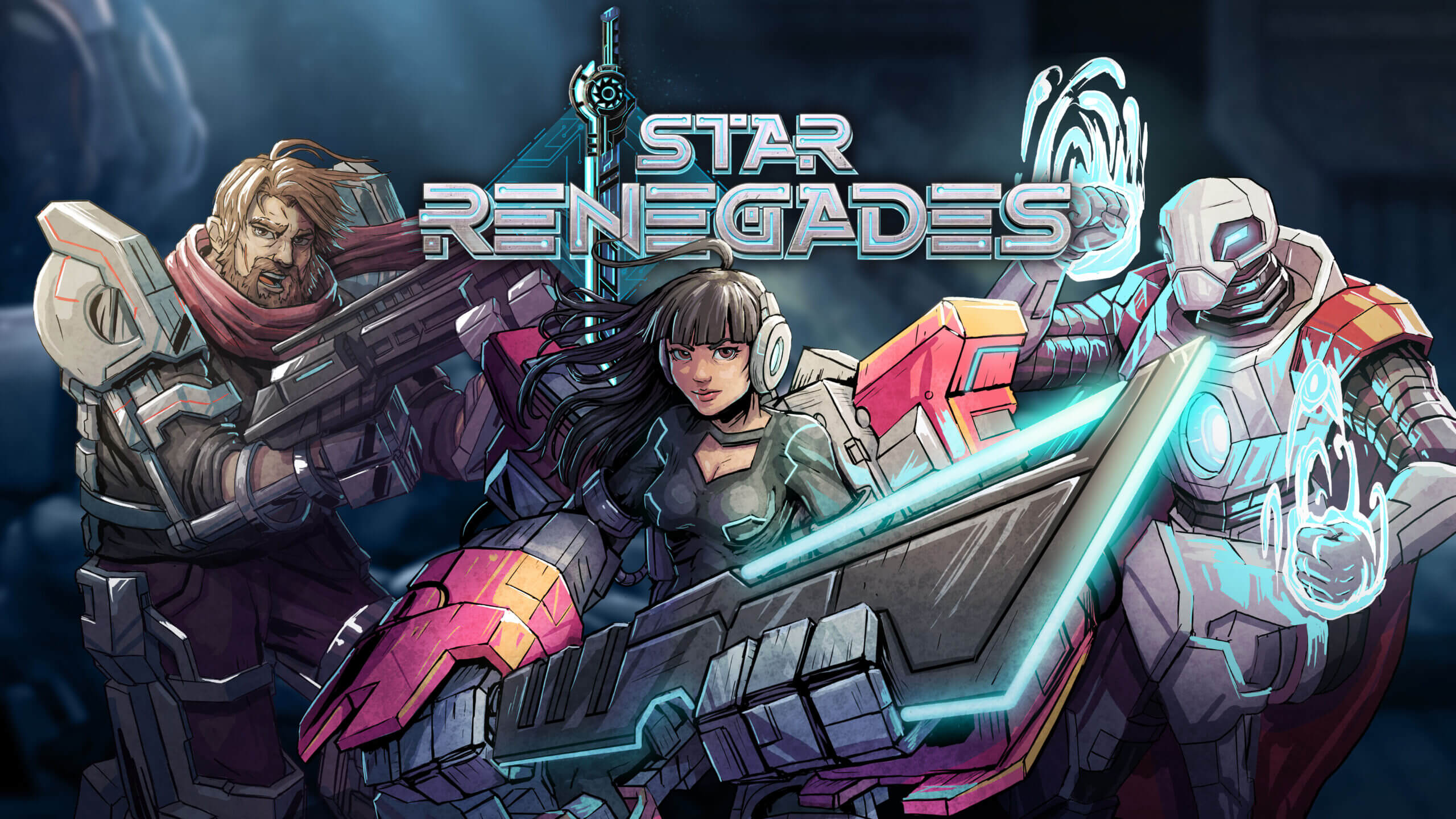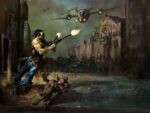A title that has enjoyable gameplay that’s hooked my attention for sustained periods of time, which is a rarity for my taste. That being said, like most games, whether someone “likes” or “dislikes” it, mainly revolves around what you as a player enjoy. Hopefully this review can answer some of your questions about this game instead of making assumptions based on the store page description; which, while not bad or something, doesn’t necessarily tell you everything you need to know to make an informed decision.
Core Gameplay Loop
Star Renegades uses a roguelite formula with JRPG-type combat. For well-known games you can use as conceptual references, I would include things such as Darkest Dungeon and Battlechasers, but mixed with common rogue elements as seen in Into the Breach, Chrono Ark, and Dead Cells. Each run takes approximately 6-8 hours (depending on how quickly you play, and how familiar you become with the game) to beat the final boss. You’ll venture through an intro section, 3 planets, and the enemy’s main ship for essentially 3 main zones with a finale on the ship which is much more abbreviated compared to the planets. Between each zone, you’ll have the opportunity to buy equipment at vendors using a temporary credits currency and recruit one more hero for your crew.
Therefore, this means that for each of the planets, you’ll have a team of 3 / 4 / 5 for planets 1 / 2 / 3, with a VIP that you have to protect who joins for the final ship zone. If you’re familiar with the game Chrono Ark (another roguelite), it’s similar in nature to that, where you’ll get your choice from 2 heroes to add to your team that run (or choice of 3 with a certain optional upgrade). Whenever your run ends (whether victorious or defeated), you’ll have the opportunity to spend your two different meta-currencies on various kinds of unlocks.
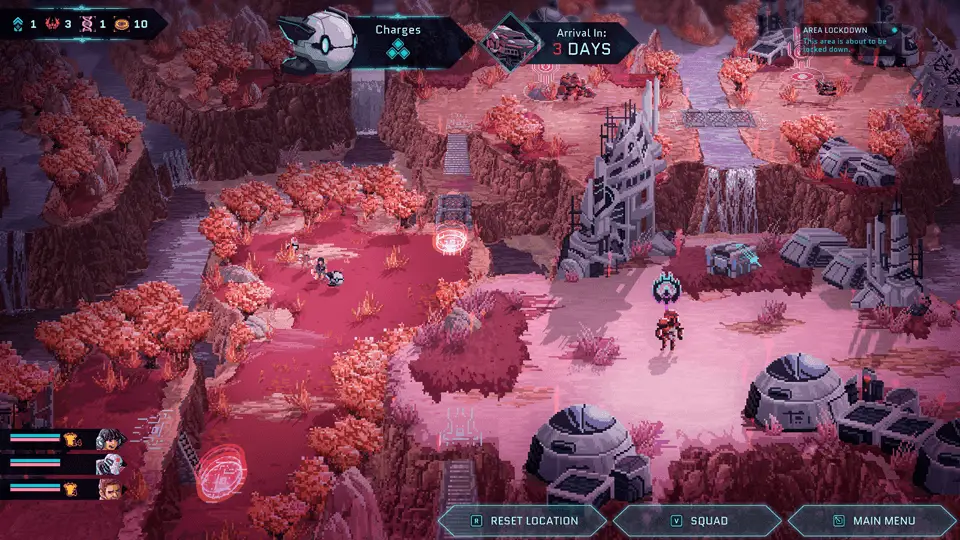
Map Exploration
Excluding the small intro section of every run which is pretty straightforward, you’ll have a total of 3 days to explore each planet till the enemy boss shows up there. Your limitation each day boils down to 3 charges of “breaking the enemy’s forcefields” to get to each part of the map. Every section has “something of value” there, whether it’s equipment, credits, shield/armor upgrades, healing crate, etc, oftentimes with an enemy encounter present. Even if there is just an enemy encounter on a spot, that still has value, as you obtain DNA (basically experience points) which you can use to level up your heroes as you desire (in a similar fashion to Chrono Ark).
The twist in exploration is that each day a couple spots will be “locked down” by the enemy at the end of the day. As a result, you have to mentally map the pathway that you plan on taking, or else important individual spots can be unavailable, or even worse; you can get “boxed out” from being able to go to any more places on that planet before the boss arrives. You have the option of reaching the “objective” spot on the map to be able to activate the boss encounter early, but really, there isn’t much incentive to do so as it’s typically best to farm the map as much as possible and gather more strength for your crew.
After using your 3 forefield-breaking-charges each day, the planet will shift to nighttime. For the most part, there isn’t that much to do at night on the whole (one exception is a basic upgrade you start with that allows you to backtrack a little bit on the map to grab some freebie credits and DNA), with the exception of some “sidequests” which can be triggered. Truth be told: triggering these sidequests seems to be very difficult as their triggers are a bit unclear. They apparently involve “defeating a special enemy on the map and finding the point of interest on the map as well”, yet, in my 25 hours of playing the game so far, thinking that I’ve done what was necessary, I’ve still yet to successfully trigger a sidequest. Apparently many in the general community have had issues with this, yet I’ve heard from friends that they have been able to trigger them — just not consistently so.
The main point of nighttime, however, is to camp. For those of you who have played Darkest Dungeon or Renowned Explorers, this will feel pretty familiar. The way things work is that your heroes have a small variety of camping abilities (as represented by cards) which are used for three purposes: Granting temporary bonuses, healing HP / repairing armor, and improving relationships between your heroes. Note that these temporary buffs only last for the following two encounters, so since you have 3 forcefield break charges each day, you’ll need to be mindful of which encounters you do first if you really want those bonuses for a difficult fight. To be clear, yes, at the end of the third day before the boss encounter of each planet, you will get the opportunity to camp to get those bonuses against the boss (the exception being for the final boss of the game — no opportunity to camp before that battle).
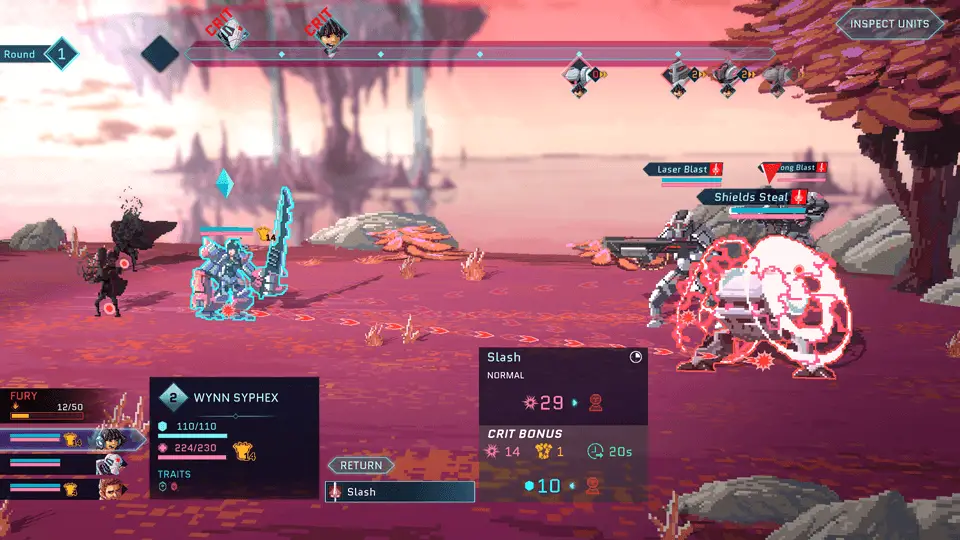
Battle System
This is really where the game shines in my opinion. I’m quite partial to the typical turn-based JRPG combat formula in general, however, Star Renegades puts some compelling twists on that. First, most abilities are free to use every turn. This means you don’t have to muck about with managing something like mana or energy. Second, there are some abilities that use a Fury resource, which you build up during combat and persist between combats on a planet.
Depending on the fury special ability in question, most can be used only once per battle, while some have no limit. Third, the game uses a kind of “time/initiative” system in combat where actions take a certain amount of “time” to execute (time being a game mechanic, it’s still proper turn-based, not ATB). The flow of each turn is visualized at the top of the game screen with portraits of friendlies and enemies, showing when they will execute their moves. Like Slay the Spire, each enemy will show their intent of what they’re going to do (though you can look at the enemies to see their precise move used — generally no guesswork there).
The main twist involved in combat is that you can stagger enemies to push them further back on the initiative bar, making them not only potentially act later, but if you push them off of the initiative bar, it will break their turn, meaning they won’t act till the following one. Note that this can’t be done indefinitely, as enemies will list how many break-charges they have available to exploit at that time, so they have to get a turn in eventually (unless you use a move which stuns them, heh). Fourth, connected to the time system is how “critical hits” are handled. Instead of a more-traditional “10% chance to crit” or something like that, crits are triggered by a unit attacking another unit before the target executes their move that turn. This makes order of events and staggering key, as the ideal situation involves always critting the enemy, and preventing them from critting you. Also, crits aren’t just “+50% damage” or something like that, but each ability will list what its crit bonus, which includes yes, more damage, but also different kinds of effects like staggering, armor break, etc.
Battle System is really where the game shines in my opinion
HP / Shields / Armor add further dimensions to the game, especially since shields are of the highest importance for keeping your heroes alive. HP and armor persist between battles (full-heal /repair between each planet) while shields are auto-full-regened at the end of each battle. Therefore, if possible, it’s best to ensure that the enemy doesn’t break through your shields or else you’ll start to feel some attrition between battles. Furthermore, as long as the enemy doesn’t pierce your shields, you’ll be avoiding a lot of debuffs, as most require striking your HP to actually apply. Armor only applies once shields are down and striking HP. Armor is relatively simple in nature, as it reduces damage taken by the unit’s armor value. Note that armor break effects also only apply once shields are broken.
For the player, armor will generally be relatively-small values and is kind of like “icing on the cake” for keeping your main tank(s) alive in a pinch, but most of the time, a few points of armor is almost meaningless for your “squishies” and will generally be broken quite easily by the enemy. On the flipside, there are a variety of enemies (especially bosses) which more or less require you to break through their armor to effectively defeat them.
Front/Backline: like some JRPGs, this game utilizes a front and backline, which makes a significant difference. Each of these has 3 slots where you can place your heroes. The idea is that most moves can only target the frontline until there are no frontline units alive. Some moves, however, have flexible targeting to hit anywhere, and AoE moves just hit both front and backlines. I really like this as it rewards using tanky heroes up front to soak up most attacks, and gives extra layers of difficulty against the enemy as you have to deal with their frontline protecting their back as well.
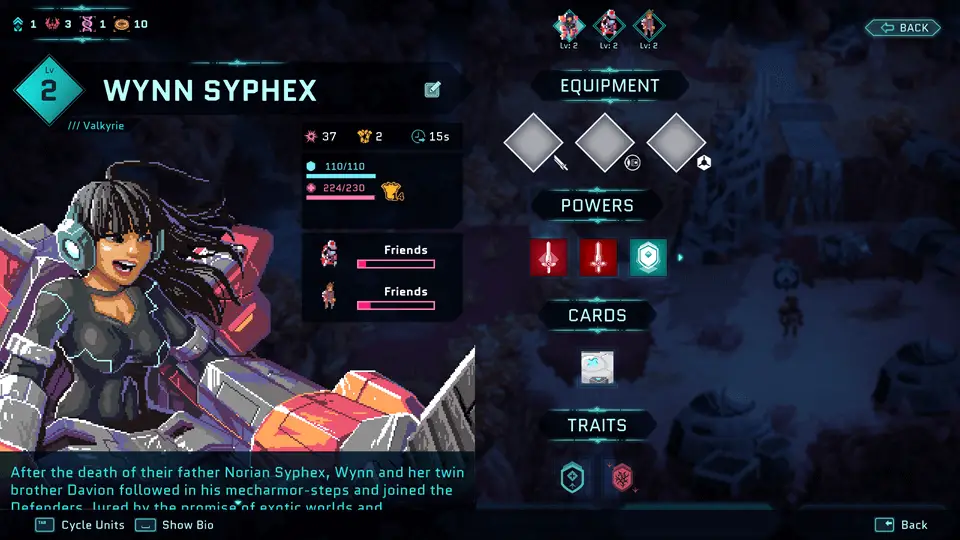
Meta Progression
Meta progression takes three main forms in this game, and are unlocked using two currencies:
Like most roguelites, this game does offer difficulty options (I’ve seen only 3 levels), for an increase of challenge for an increase in meta-currency gains. Merely beat the game on a given difficulty to unlock the following one.
The robot upgrades (little flying thing that goes with you everywhere) are a “choice of one” situation with some pretty cool stuff, including things like some free armor repair when camping, more vendor options between planets, and more flexibility in adding heroes during your run (choice of 3 instead of choice of 2).
Equipment unlocks work in a similar fashion to something like Dead Cells, where once you’ve unlocked certain pieces, they’ll potentially show up in future runs.
An important aside about equipment unlocks: There is one really good and one really annoying aspect to this system:
- The Good: You can choose one piece of equipment to start with on every run. It will just be the level 1 version of it, but, this can help things go a lot smoother from the get-go. I really like this, as it gives you “one more little significant choice on your starting loadout”, especially as the early parts of a run can be a little more difficult before your crew develops that much.
- The Annoying: Unfortunately, Massive Damage didn’t learn the lesson about equipment unlocks that Dead Cells eventually did: you can unlock “subpar equipment” which just dilutes the item pools with stuff which is clearly inferior to others. This, therefore, incentivizes the player to “skip over” unlocks for pieces of equipment which they deem “not as worth it”. I can feel hopeful that perhaps Massive Damage will reconsider the way that item pools work in a similar fashion to how Dead Cells allowed the player to remove things from the possible item pools. Otherwise, players can end up going “oh no, I’ve made things worse for myself by unlocking X item, and I can’t do anything about it unless I start a fresh file”.
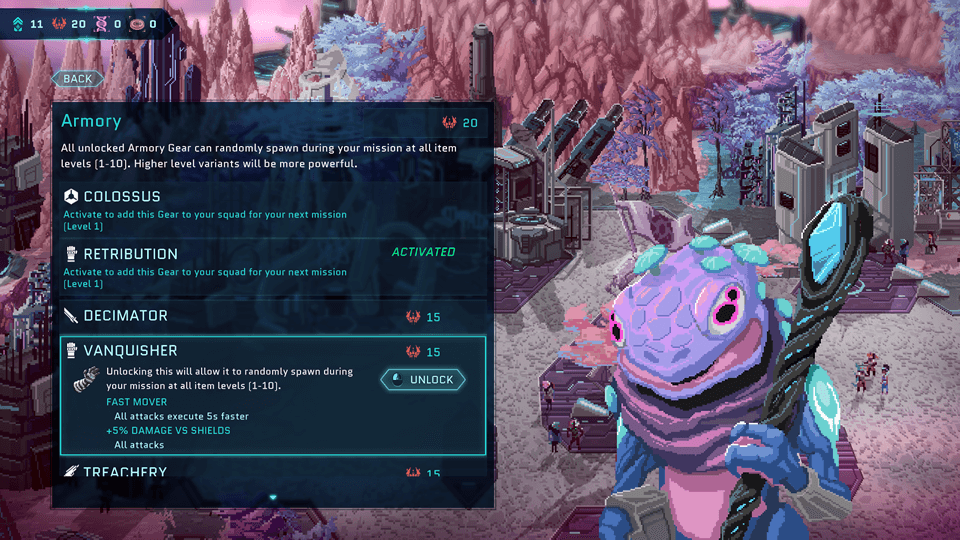
Hero unlocks tie in mainly with the relational system which I made mention of in the camping description. Most heroes will only have relational levels up to tier 3, but some will have up to tier 4. Tier 1 gives a small passive bonus to each hero, tier 2 unlocks their fury combo ability (kind of like a duo-limit break), tier 3 unlocks another small passive bonus, but tier 4 unlocks the ability to purchase “Progeny Heroes”, to give you more options for your crew in the future. Note that the relational system and its bonuses (save for the meta-unlock of progeny) is on a per-run basis, and not permanent.
To clear up one very important aspect about how Progeny Heroes work (minor mechanical spoilers)
There are only 4 “new heroes” to unlock through this system. All of the other progeny heroes are merely variants of the 13 heroes in total. This is not to say that “this sounds lame compared to what the store page made it sound like”, but moreso to temper players’ expectations about the game. These variants on the heroes are actually pretty neat, as they’ll have adjusted base stats and small differences on their active abilities, such as swapping out A ability for B, and/or learning certain abilities at differing levels than their other progeny variants.
The second kind of hero unlock you get are class perks for the various heroes. As you gain the blue currency during your runs, it will go into a meta-counter which you level-up in. When you reach certain thresholds of this, it will unlock a second / third / etc class perk for each hero. This therefore gives you starting loadout options of either “Rookie” (which makes relationships improve faster) / class perk 1 / class perk 2 / etc for your three starting heroes. Along with the various cool bonuses these can offer, it also changes the color scheme on your hero for a nice effect.
So How Extensive Are the Hero Customization Options?
To lay out the various factors on this:
- Each hero has a pre-packaged progression from level 1-10 on a run. There’s no direct choice of abilities or talents or something, instead, your hero gains an active ability on 2/4/6/8/10, and a camping card at 3/5/7/9. As mentioned above, differing progeny variants on heroes affect what is unlocked and at what level.
- Each hero has a class perk you can pick at the beginning of a run. Note that this only applies to your three starting heroes, not the other 2 you pick up during a run.
- Each hero has 3 equipment slots. What these slots are pre-determined based on the hero themself. A typical balanced hero may have a sword / an implant / a device, while another may be more offensive with a blaster / a rifle / and a device. Given that equipment is actually very important in this game when evaluating which heroes you want to use, keeping in mind which equipment can or can’t be shared between people is going to be useful.
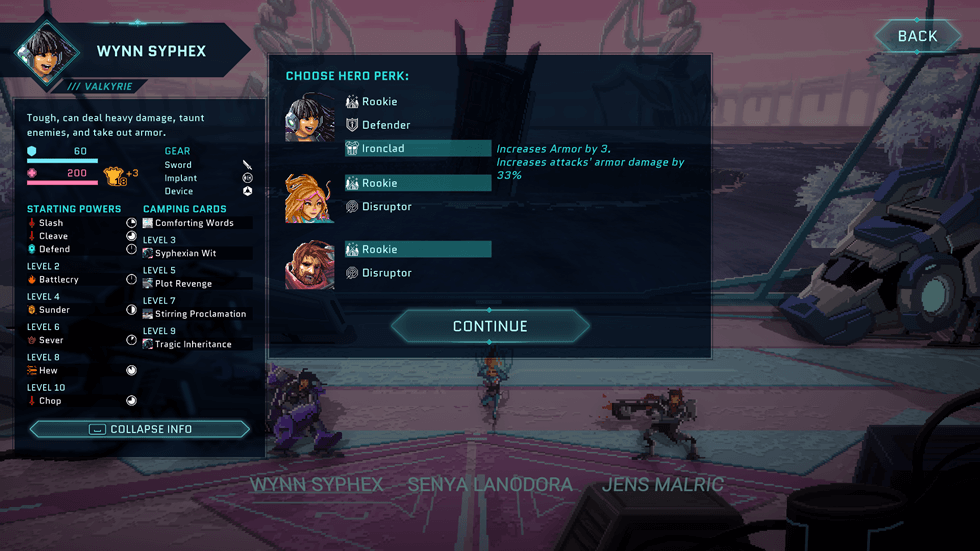
Bugs and Issues
In many ways, the fact that I have to include this is a negative, but, I want to be as informative as possible. The amount of issues can vary from player to player, but to list some issues which I encountered:
- Visual bugs, such as the “corpse” or unit model of a defeated unit still standing on the battlefield. It’s been pretty rare (maybe twice that I can think of), but I’ve heard it reported by others as well.
- Some mechanics not acting properly/as intended. To go into detail would be difficult, but, suffice to say, there is some stuff to fix (not that it’s ever been of a major hindrance to me so far).
- Some achievements not unlocking properly (as of writing this review I’m still missing the achievements you get from doing the tutorial stuff).
Some “Issues” I’ve encountered (not necessarily “Bugs”)
- Movement pathing of your party on the exploration screen is…not great. When you tell it to go to a spot, it just paths the closest distance from X to Y…regardless of any turns or obstacles in the way. As a result, you have to semi-micromanage your movement on the map. Annoying, but not game-breaking. Similarly, when moving to different parts of the map, you have to click specifically on the “go to this next area” marker on the map. This becomes tedious when trying to travel further distances on the map because you can’t do this in one click, but instead, have to go from A to B to C, etc. Lastly, there have been times in some tighter map areas that I’ve accidentally clicked the “switch area” spot and had to click it again to get back to where I was.
- The visuals / UI can become slightly obscured at times. Sometimes, certain elements of the UI in battle can end up covering up certain explanation boxes or units. As a result, I’m careful about which heroes I place in which spots of the frontline/backline of my formation, just for sake of some of the smaller hero models being covered by some larger ones. Also, one instance which stands out to me is the fight “right before the final boss”, which has a couple of summons which semi-obscure the main mini-boss.
- You can see heroes abilities in the “select your 3 heroes” screen at the beginning of a run, but can’t view their progression during a run (save for “next level up grants X”) or when choosing which hero to add to your crew (it only gives you a very basic overview of their strengths).
Many effects don’t give descriptions of what they do on the item itself. Example, a weapon can say “Causes Chilled VII”, but doesn’t say what precisely chilled does. Instead,in combat, you can press X on your keyboard when selected over a unit to see the effects of the present buffs/debuffs. As of a patch on September 22, 2020, this is no longer as issue, as you can now press Shift while hovering over an equipment piece with an effect, and a popup tooltip will display a description of the effect.
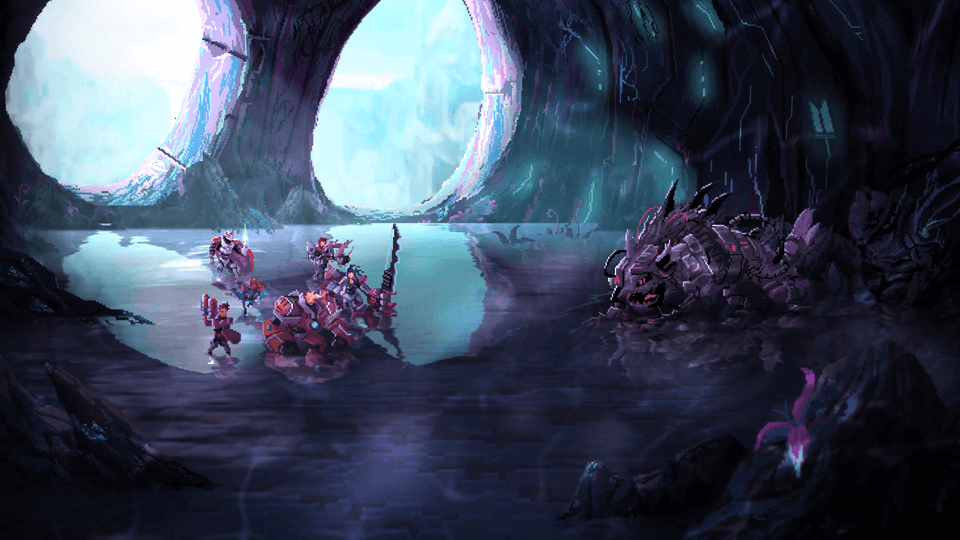
Final Thoughts and Comments
For the various flaws that Star Renegades has, I am optimistic that Massive Damage will smoothen things out with post-launch support. They’ve been quite receptive to the player base’s bug reports, and have announced plans for more content development.
I love the game’s battle system and how it makes me think a lot with every turn. Every situation I’m faced with is a puzzle on “ok, how am I going to deal with this?” Executing those perfect turns and combos feels satisfying, and when you take casualties, it’s a learning experience on “ahh, yeah, I should watch out for those kinds of issues next time”.
Some may not be too thrilled with how each run takes “so long” (6-8 hrs) for a roguelite, but personally, I’ve been fine with that, as I can comfortably save and exit whenever I need to and continue next time.
I’m not super into story/thematics on games, so my opinion on them on Star Renegades is that it’s not a game you play for the story. I’ve heard both praise and complaints for its non-serious and comedic tone, with plenty of dialogue interactions which honestly don’t make sense. Such things don’t bother me as there’s just “thematic fluff” on the game’s actual mechanics. Basically, the story isn’t something incredibly deep or long to keep you motivated to play — you’re playing this run after run cause you like the game.

